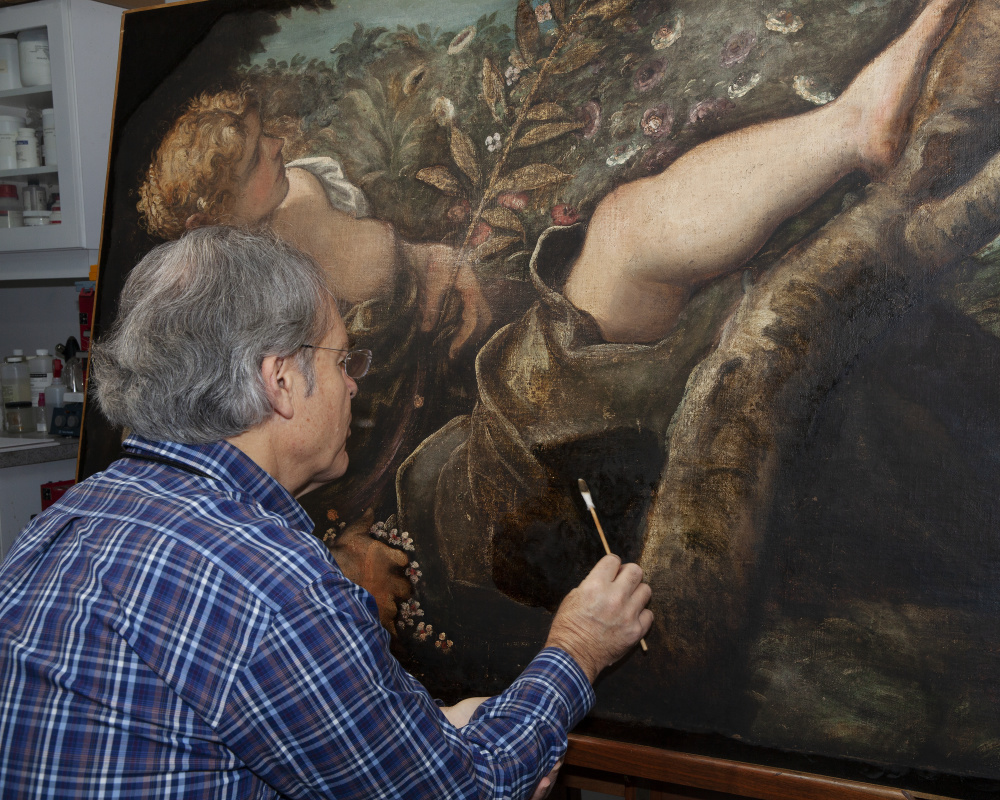- Open today, noon to 5 pm.
- Parking & Directions
- Free Admission
On the Road to the National Gallery

Mark Lewis cleaning Allegorical Figure of Spring by
Jacopo Robusti (Tintoretto) in Conservation. December 2018. Photo by Ed Pollard.
To commemorate the 500th anniversary of the birth of Jacopo Robusti (Tintoretto), the Chrysler’s Allegorical Figure of Spring will be on view at the National Gallery of Art in Washington, D.C. starting this spring. It will appear alongside other works by the great Venetian artist in Tintoretto: Artist of Renaissance Venice, the first retrospective of the artist in North America.
Around 1546, Tintoretto was commissioned to create several works for Palazzo Barbo in Venice, including a huge ceiling painting depicting The Allegory of the Dreams of Men and a series of figures personifying the four seasons on the four walls. Walter P. Chrysler, Jr. purchased Allegorical Figure of Spring in the decade following World War II and gifted it to the Chrysler in 1971. Summer is at the National Gallery of Art, and Fall is in a private collection in Japan. Winter has been lost.

Mark Lewis cleaning Allegorical Figure of Spring by
Jacopo Robusti (Tintoretto) in Conservation. December 2018. Photo by Ed Pollard.
Before going on the road for this celebration, the Chrysler’s painting underwent extensive cleaning and restoration. The Museum collaborated with the National Gallery of Art and Old Dominion University (ODU) to restore the work. An initial examination of the piece revealed black and brown discoloration in the foliage that was likely caused by the use of copper resinate, a beautiful transparent green commonly used in the Renaissance. Because the paint is made of copper and pine resin, it can mysteriously turn brown over time. Scientists from the National Gallery examined small samples of our painting and used microscopy to help us better understand the many layers of paint used by Tintoretto to create the work.
To identify the pigments the artist used, we enlisted the help of Old Dominion University Chemistry faculty member Dr. Craig Bayse and graduate student Sarah Horne. They examined the Tintoretto painting using X-ray fluorescence technology, a nondestructive, analytical technique that uncovers information about the elemental composition of an object. A series of cleaning tests revealed that, although some of the greens had darkened over time, the biggest issue was layers of discolored overpaint that had been applied in previous restorations. We removed the overpaint, uncovering the original colors of the foliage that were much brighter and closer to what the artist created centuries ago.
Restoration of Allegorical Figure of Spring was made possible by contributions from the Museum’s Honorable Society of Former Trustees.
—Lloyd DeWitt, PhD, Chief Curator and Irene Leache Curator of European Art and Mark Lewis, Conservator
Jacopo Robusti (Tintoretto), Allegorical Figure of Spring, ca. 1555, Gift of Walter P. Chrysler, Jr.

